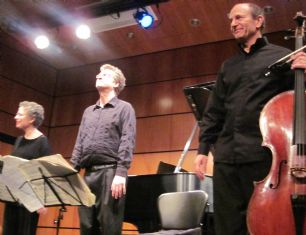|
Symphony
FROM THE NEW WORLD TO THE OLD WORLD
by Peter Lert
Saturday, June 14, 2025
Chamber
MC2 DUO RECITAL CLOSES 222'S SEASON
by Terry McNeill
Saturday, June 14, 2025
Choral and Vocal
CANTIAMO SONOMA'S LUSCIOUS A CAPELLA SINGING IN SEASON ENDING CONCERT
by Pamela Hicks Gailey
Sunday, June 8, 2025
Symphony
SRS SEASON ENDS WITH RESOUNDING TA-TA-TA-BANG
by Terry McNeill
Sunday, June 1, 2025
Symphony
YOUTHFUL VIRTUOSITY ON DISPLAY AT USO'S MAY CONCERTS
by Peter Lert
Saturday, May 17, 2025
Symphony
MYSTICAL PLANETS AND LIVELY GERSHWIN ORTIZ AT FINAL SRS CONCERT
by Peter Lert
Sunday, May 4, 2025
Symphony
VSO'S CONCERT MUSIC OF TIME, MUSIC OF PLACE
by Peter Lert
Sunday, April 27, 2025
VOCAL ELEGANCE AND FIRE AT THE 222'S RECITAL APRIL 26
by Pamela Hicks Gailey
Saturday, April 26, 2025
CANTIAMO SONOMA SINGS AN INSPIRED GOOD FRIDAY MOZART REQUIEM CONCERT
by Pamela Hicks Gailey
Friday, April 18, 2025
DRAMATIC SHOSTAKOVICH SYMPHONY CLOSES PHILHARMONIC'S 25TH SEASON
by Terry McNeill
Sunday, April 13, 2025
|
 |
 Gramercy Trio in SRJC's Ellis Auditorium Oct. 11 |
MERCI BEAUCOUP, GRAMERCY
by Terry McNeill
Friday, October 11, 2013
The Boston-based Gramercy Trio opened the SRJC Chamber Music Series Oct. 11 with three trios that leaned heavily on powerful thematic projection and trenchant sound.
Before 160 people in SRJC's Ellis Auditorium in Petaluma, the Gramercy opened with a muscular reading of Beethoven's massive "Archduke" Trio in B Flat, Op. 97. Pianist Randall Hodgkinson pushed the pace throughout the work, playing spiky but effective sforzandos and seemingly insisting on more sonority from violinist Sharan Leventhal and cellist Jonathan Miller. During the Beethoven and throughout the evening Mr. Hodgkinson's playing was loud, but the instrumental balances were never off, nor did he cover his partners.
Mr. Miller's cello playing was a foundation in the opening Allegro Moderato after some pitch variance, and his sound was most rich in the lower registers. In the lovely Andante Cantabile, the violin line soared after an engaging duet with the cello, and Mr. Miller used drone-like passages to subtle effect.
The extended finale was at all times propulsive, the pianist occasionally smudging notes in the chase for a potent musical statement. It wasn't a performance for the timid, but I found it provocative and convincing.
Gunther Schuller's Third Piano Trio, a three-movement work from 2012, opened the second half. Commissioned by the Gramercy, the trio's complicated rhythmic structure struggles in the opening Tempo Moderato to be heard through an array of string slides and insistent outbursts and low-bass resister rumblings from the piano. Ms. Leventhal played captivating tremolos at the top of her violin's range. She continued these acrobatics in the Largo with a long double-stopped solo passage in the mid-range, with the cello playing in a mournful duet, many octaves apart.
Tremolos in all three instruments began the final movement Presto, then in syncopating rhythms, slipping into a pulsating and languorous tango style. The violin and piano lines interwove with a controlled frenzy that ended abruptly in a loud single bottom A in the piano.
One felt this daring work could not be played better, or with more visceral impact.
Could the high-voltage playing continue? It did indeed with a full-throttle reading of the wonderful Ravel Trio. The composer's high level of masterpieces surely includes this virtuosic piece from 1914. The Gramercy played the marvelous opening Modéré with élan and wider string vibrato than in the Beethoven. Breathless speed and enveloping climaxes unfolded in the second movement, with Mr. Hodgkinson playing just about every note of the piano. Elegant playing characterized the following Passacaglia, with the piano and cello in a dignified slow march and Ms. Leventhal's violin entering deftly to sweeten the texture.
Playing the impressionistic and faintly oriental concluding Animé with washes of color, the Trio was in an orchestral mood. The intricate counterpoint built inexorably to a fortissimo but wholly controlled finish. This was an irresistable Ravel performance, the three musicians completely at ease with their energetic conception.
|

